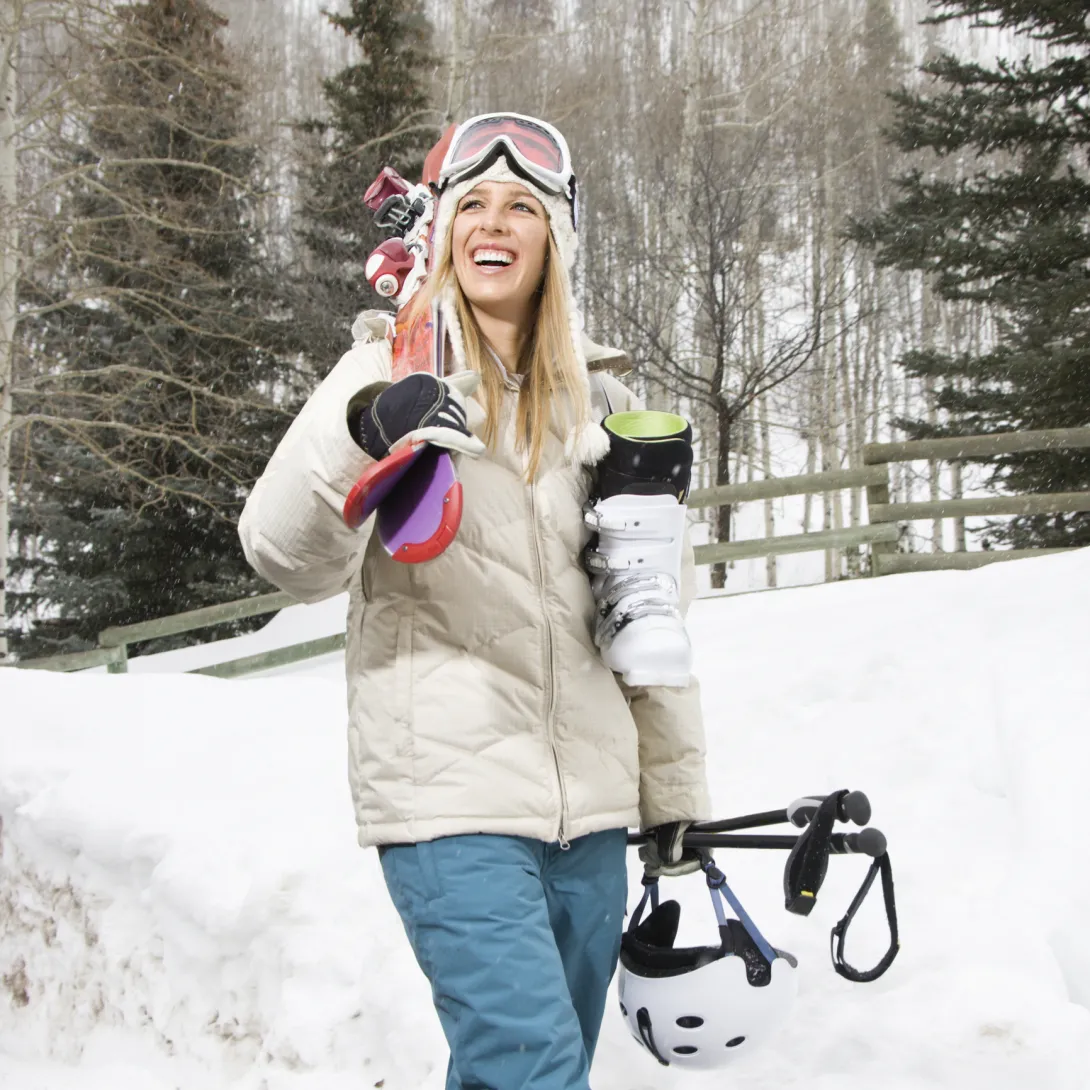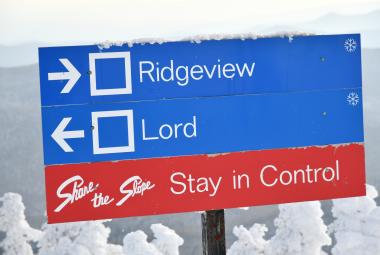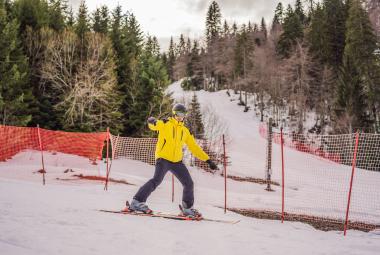Skiing is perceived to be more of a dangerous sport than it really is, though your safety while skiing is something you certainly need to take seriously. Accidents do happen while skiing, but the biggest risk you could ever take is being uneducated.
In general, most common ski injuries and accidents can be avoided with some basic knowledge and planning. Be sure to brush up on the basics before heading out this winter so that all you have to focus on is having fun.
Keep reading to learn our top 10 ski safety tips for beginners!
Work on your fitness outside of the ski slopes

When you’re spending the day flying downhill rather than trekking up it, it can be easy to assume that skiing is not a very energy intensive sport. But in reality it’s not difficult to burn up to 600 calories an hour while skiing.
And if you skip leg day one too many times, you’ll find that your legs will give out on you before you want to stop skiing for the day. Working on your fitness outside of the ski slopes will allow you to have the endurance to ski as much as you want, the strength to test your limits, and will help avoid accidents.
Many ski accidents occur from fatigue. Work on your fitness outside of the ski slopes and you’ll find that your time on the slopes is so much easier!
Read more: 8 Mistakes Not To Make As A Beginner Skier
Don’t skip out on lessons

One of the most common questions we hear from beginner skiers is “Do I really need lessons?” and the answer is a definite YES.
While there are plenty of free videos on the internet that will teach you the mechanics of how to ski, learning how to ski from a professional who can give you one on one feedback is worth its weight in gold. Your instructor will also teach you all about ski safety so you can take risks with confidence.
Even if you already know how to ski, taking lessons is a great refresh or way to reach the next level. So don’t skip out on ski lessons!
Read more: How Many Ski Lessons Do Beginners Need?
Wear a helmet and ski goggles

The second most common question we hear from beginner skiers is “Do I really need to wear a helmet and goggles?” and the answer is also a definite YES.
We understand that ski equipment can be expensive, but there are many items you can’t skip out on, such as a helmet and goggles. We don’t hear as many complaints about helmets nowadays because most people understand how important it is to protect your brain from injury.
Ski goggles are just as important as they protect your eyes from UV light and anything that may be flying back at you such as snow and wind. In order to prevent injury to the brain or eyes, be sure to wear a helmet and ski goggles.
Read more: Finding the best ski goggles
Have the right equipment

Making sure to have the right equipment for you while on the slopes is one of the most important factors of both safety and comfort.
If you don’t wear the right clothing you could easily become wet and miserable which can lead to frostbite. Not having the right skis for your size and skill level could have you flying down the mountain out of control.
Having the right equipment will ensure that you stay safe and comfortable on the mountain all day, so all you have to focus on is improving your skills.
Read more: Should You Rent or Buy Ski Equipment?
Take the time to learn how to evaluate conditions and pick your lines properly

Picking your lines properly is one of the most important skills you can develop as a safe skier.
When you’re on green and blue runs at a ski resort you won’t have to worry so much about picking your lines but you will need to watch out for ice, storms, and any other potential hazards. It’s good practice to learn how to monitor conditions as early as you can.
If you develop this skill as a beginner, you’ll feel confident when you begin venturing off-piste. Be sure to study safety awareness before you hit the slopes to avoid possible injuries.
Yield to skiers in front of you

So many accidents (and even just fights) happen on the ski slopes due to miscommunication on who should be moving out of who’s way. The rule is that the skier in front has the right of way and the skier behind needs to yield to them.
We as humans do not have eyes in the back of our heads. I find there’s a misconception that if you yell “behind”, many people seem to think that means that the skier in front should pull over. In reality, this signals to the skier in front that they should continue on the path that they are currently on and not make any sudden turns until the skier behind passes.
Watch out for skiers in front of you. Listen for skiers behind you.
Look both ways before merging or pulling out

Drill this phrase into your head: Look both ways and uphill.
Before you pull out to take off down the slope, look both ways and uphill. Before you merge or change direction, look both ways and uphill. It’s not easy to maneuver around so many people flying down the slopes all at once. Just like in driving, before you make any significant movements you need to make sure the coast is fully clear. So look both ways and uphill.
Never stop in the middle of the slope

It’s normal to want to take a little break mid-run whether it be because you’re tired or lost. If you end up at a fork in the road and you don’t know which way to go, don’t ever just stop in the middle.
When you find yourself needing a little ski break, look both ways and uphill then pull over to the side to rest and recover or decide on your next move.
Be honest with yourself about your skill level

Many injuries and accidents occur from overconfidence and pushing your limits a little too far. Before you make a move or try to go alone, be honest with yourself about where you’re at so you can test your limits safely and avoid injury.
Stay hydrated

Don’t forget your water bottle on the ski slopes and be sure to actually drink from it!
When you’re flying down the mountain it can be tough to remember to take a drink, but you’ll feel it real fast if you don’t stay properly hydrated. I always just make sure to take a swig when I’m on the lift or at the lodge and find that that does a great job of keeping me hydrated throughout the day.
Bonus tip: Have fun!

More than anything, remember to have fun on the ski slopes!
The tips above aren’t here to scare you out of taking risks. They’re here to give you the knowledge and confidence you need to take them safely. So get out there, wear your helmet, listen to your instructor, and have a great time!







